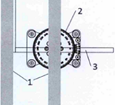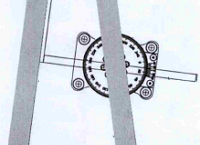SYSTEM FOR THE MEASURE OF BINOCULAR VISION
|
Description |
Diagram: tubes (1) in parallel. Scale (2). Separation bar (3) adhered to the side of one of the tubes.
This device allows the evaluation and treatment of binocular vision problems through two tubes that are coupled on a scale of measure angles. The tubes are separated from each other by a bar that can be lengthened or shortened depending on the interpupillary distance or between the eye lines of each eye.
|
How does it work |
The evaluation of binocular vision is usually done through a visual examination to then treat the refractive error with glasses or contact lenses. This error can also be corrected with visual therapy if it is associated with some accommodative anomaly.
The most common accommodative anomaly is diplopia or double vision. It is generated when both eyes are not associated with the same image simultaneously in both retinas. This deviation is measured with prisms, dissociators or heavy and fixed equipment.
This optometric system allows to measure the ocular deviations according to the angle of one tube with respect to the other. This angle corresponds to the limits of the synchronized movement of both eyes when moving in opposite directions.
|
Advantages |
• It is a light and portable equipment, which does not need heavy or sophisticated instruments.
• It is a cheaper equipment because it is not so complex.
|
Where has it been developed? |
The design, protected by national patent with previous examination since 2016, and its prototype, have been developed in the Faculty of Optics and Optometry.
|
Contact |
|
© Office for the Transfer of Research Results – UCM |
|
PDF Downloads |
|
Classification |
|
Responsible Researcher |
Ricardo Bernárdez Vilaboa: rbvoptom@ucm.es
Department: Optometry and Vision
Faculty: Optics and Optometry




